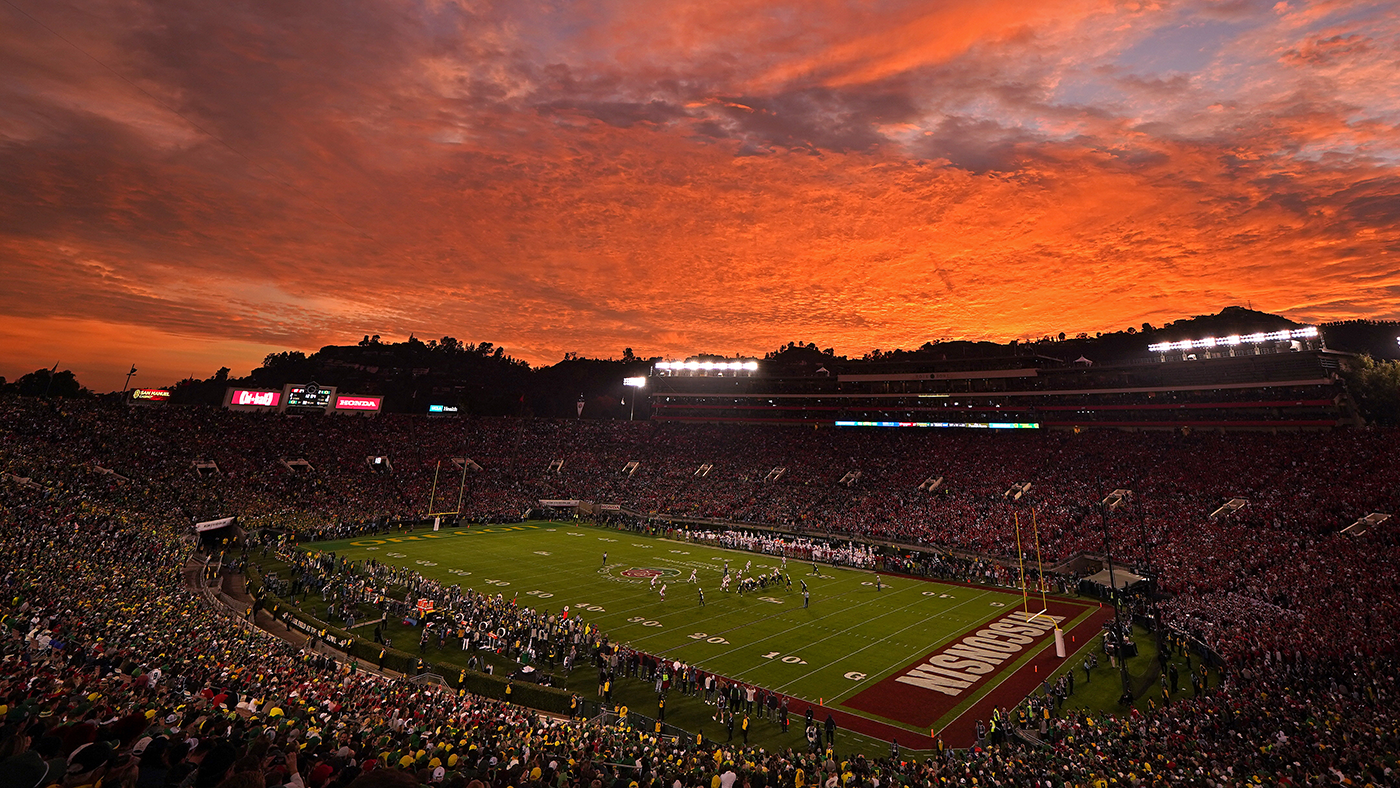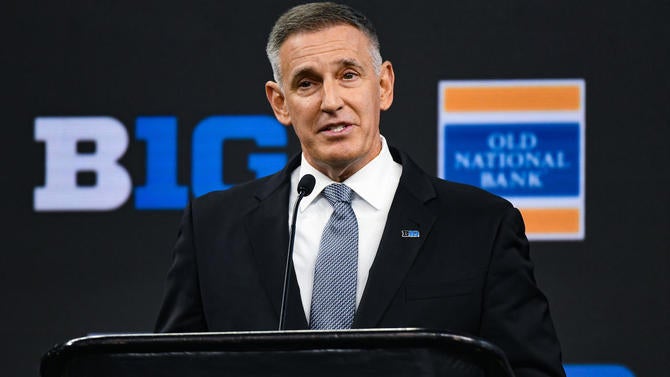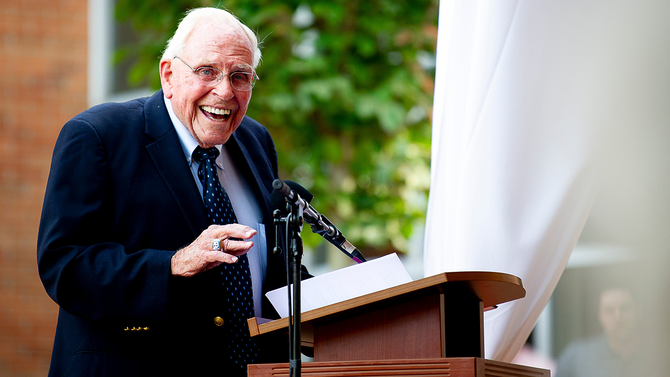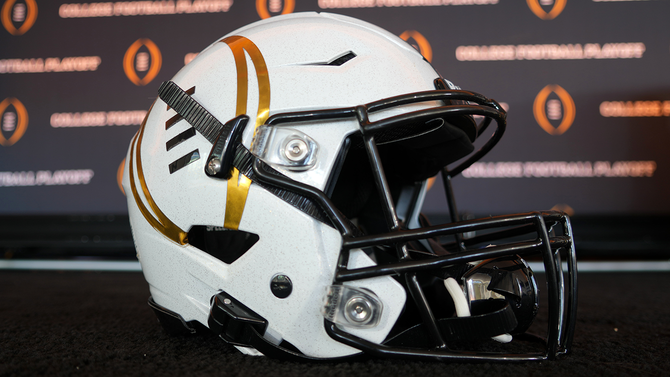Selling (the) Sunset: How Rose Bowl acquiescing to BCS carved path to expanded College Football Playoff
Written by CBS SPORTS ALL RIGHTS RESERVED on December 20, 2023


The accountants at ABC Sports had spoken. There would be no new money for a Rose Bowl extension. In the mid-1990s, sports television revenue was booming … but just not enough at that moment in a Pasadena, California, hotel ballroom. ABC Sports executives Tony Petitti and Dennis Swanson had flown across the country to deliver what was not necessarily bad news but rather no news for their partners.
Awaiting in that ballroom just minutes from the grand-old stadium itself were eager executives from the Pac-10, Big Ten and Rose Bowl. The relationship had been college football’s version of titanium — an unbreakable bond since the champions of the two leagues began playing in the Rose Bowl in 1947.
But bean counters being bean counters, it wasn’t a good time for the Rose Bowl to expect more money. The two leagues were already splitting $11.5 million in rights fees.
“We flew out there with empty pockets with no real idea about what to talk about,” recalled Petitti, now commissioner of the Big Ten, about that 1995 meeting.
Some of the most powerful administrators in college sports were floored. Petitti and Swanson dropped a bomb on them that contained no explosives … and even less money.
The ABC Sports executives were told to wait in a hallway while the room digested what just happened. When then-Big Ten commissioner Jim Delany emerged, they were told the only issue discussed was how to throw them out of the building.
“Then they proceeded to tell us how disappointed they were,” Petitti said. “That was the end of the meeting.”
That tight circle was a paradigm of the crossroads in which college football found itself a quarter century ago. It also served as a birthplace, of sorts, as the sport celebrates the 26th anniversary of its championship being decided on the field.
“This [was] the beginning of the BCS,” Petitti said of that ill-fated meeting.
It was more than that. The Bowl Championship Series was the first system created to annually match the top-ranked college football teams to crown a national champion. It has since morphed into the College Football Playoff, which will expand to include 12 teams in 2024.
“The reason why it [all] worked … We were taking the college football postseason and keeping it away from the NCAA,” Petitti said.
That was the understated intent from the beginning. The NCAA Tournament had long since grown into a billion-dollar enterprise profiting off men’s basketball, but schools still play for monetary “units” that go into conference coffers before being divided evenly among members.
College football stakeholders wanted to keep the majority of postseason revenue for themselves. Those stakeholders — primarily the Power Five conferences you know today — created value for the sport they didn’t wish to share.
In one prominent exchange, former WAC commissioner Karl Benson said his teams just wanted a chance to play on “the big stage.”
Delany famously shot back: “The problem is your ‘big stage’ takes away opportunities for my teams to play on the stage they created in 1902.” That was the first year of the Rose Bowl Game.
College football remains an exclusive club that’s only become richer and more exclusive amid conference realignment.
Texas later this month becomes the 14th team to participate in the CFP across its 10 years of its existence. Only 16 teams played in the BCS Championship Game over its 16 years. A total of 23 teams have occupied 72 combined BCS/CFP slots.
Since 1998, nearly as many teams have joined the FBS (21) as have played for its championship.
That’s why the CFP is a separate limited liability corporation unaffiliated with the NCAA. That’s why, in the next CFP television contract, it’s possible the Big Ten and SEC demand an uneven share of revenue in a deal that could surpass more than $1.5 billion annually.
The stakeholders might have narrowed, but the intent hasn’t changed since that day in Pasadena.
Before being ushered out of the meeting, Petitti and Swanson provided a glimpse into the future.
“What we basically said is, ‘It’s shifting. It’s more about 1 vs. 2. It’s not about traditional Rose Bowl matchups anymore,” Petitti recalled. “I’m not sure we believed it. We didn’t have any plan.”
But they did have it right … eventually. Incrementally, that exclusive club was shape shifting.
“I think they all wanted a 1 vs. 2, but the other motivation [was] … they didn’t want the control of the college football championships to go to the NCAA,” Petitti said.
There is no one person who “invented” the CFP, but there is a genesis story that begins with Petitti finding a clause hidden in a contract nearly three decades ago.


As disastrous as the meeting had been, Swanson told Petitti a seed had been planted with the Rose Bowl partners. Never mind that it didn’t germinate for a while. Decades-old beliefs, traditions and fiefdoms had to be replaced and reconsidered. Even if extra money wasn’t available from ABC, more potential dollars existed in the system than anyone could have imagined at the time.
It had to start with the Rose Bowl.
“It was sort of 180 degrees from what they thought we were going to say,” Petitti said. “They kind of stared at us.”
The Rose Bowl was key because it was the first, oldest and most powerful postseason game. You couldn’t proceed past the convoluted bowl structure — rife with backroom deals — unless the Rose was on board.
The Rose Bowl debuted as a tourist attraction hoping winter-weary Midwesterners would fly to California and watch their teams play against the best in the West. It evolved into a television and competitive tour de force complete with its own signature sunset and trademark voice. (Thank you, Keith Jackson.) And the parade. Don’t ever forget the Tournament of Roses Parade.
In the 1990s, college football’s postseason was tilting ever so slowly toward on-field resolution. The Bowl Coalition evolved into the Bowl Alliance. It moved the sport closer to crowning a true champion. But to reach that destination, the Rose Bowl first had to loosen its partnership with the Big Ten and Pac-10.
During a somber flight back to New York, Swanson told Petitti it had been a great first meeting. The 34-year-old junior partner was incredulous considering they had been shown the door.
“Now that they know we’re serious, they gotta do something different,” Swanson explained.
“I knew Dennis well enough. When he said, ‘You’re going to look at a plan,’ he meant it,” Petitti continued. “He actually meant he wanted me to figure something out.”
That’s where the invention comes into play. Swanson, now 85, was a brilliant TV executive having worked for ABC, CBS and Fox. He helped create “The Oprah Winfrey Show.” It was at his suggestion that the Olympics began staggering the summer and winter games two years apart.
Swanson had enough faith in college football, in the future, in the Rose … and in Petitti. Before leaving for New York, he suggested a movie. They chose “Outbreak,” but the jet-lagged Swanson fell asleep within 5 minutes.
“He then gives me a whole recap of the movie which he didn’t see,” Petitti said.
The challenge was clear: If Swanson could review a movie he hadn’t seen, Petitti had better come up with a pitch the Rose Bowl would buy. Petitti eventually found a clause in the Bowl Alliance contract that voided the deal at any time if a No. 1 vs. No. 2 matchup could be arranged. That opened the door … only if the Rose Bowl agreed.


A 94-year-old man in a wheelchair remembers.
To sell the concept to the Rose Bowl, Petitti knew he needed then-SEC commissioner Roy Kramer on board. Kramer had exploited a little-known NCAA codicil that allowed his conference to play a championship game beginning in 1992. That concept was quickly adopted by other leagues, and it remains a standard across the sport’s landscape.
Back then, however, the awkwardness of ABC going to Kramer was apparent. CBS held the SEC’s regular-season television rights at the time, but Kramer was key to the sell job. He had that much juice; his voice and opinion carried weight. If Kramer told the Rose Bowl a No. 1 vs. No. 2 game was in its best interest, it just might work. Might.
“Tony talked me into going out and speaking to the Rose Bowl committee,” Kramer recalled earlier this month, the day he was inducted into the College Football Hall of Fame. “I’ll never forget I had this big presentation about how great it would be for the Rose Bowl. After about 20 minutes, [Pac-10 commissioner] Tom Hansen stood up and said, ‘Are there any questions?’ I didn’t get a single question. They weren’t in favor of it.”
External pressures were already closing in. Fiesta Bowl executive director John Junker gave us a glimpse helping arrange No. 1 Miami vs. No. 2 Penn State in his 1987 game. A college football playoff had been discussed openly since at least 1988.
Thirty years ago, Nike and Creative Artists Agency presented to the NCAA a proposal that promised $100 million for an eight-team playoff. In 1994, UCLA chancellor Charles Young chaired a 24-person committee that issued a 500-page report exploring formats ranging from two to 16 teams. In 1999, a Swiss marketing company offered university presidents $3 billion over eight years to stage a playoff.
But in the mid-1990s, the conferences weren’t quite ready. Clearly the Rose wasn’t ready.
It was suggested, if “The Granddaddy of Them All” gave up the Big Ten vs. Pac-10 matchup once every four years — in a rotation with other major bowls — an annual national championship game could be arranged.
It was a matter of untangling bowl commitments and network contracts. Everyone could make more money. The game and its fans would get closure on an annual basis. Cities and bowls could bid on the championship game. In an age when the internet was just emerging, the BCS created content that could be spread across multiple platforms.
“It wasn’t like a ‘Eureka!’ thing in my mind,” said Rick Chryst, then an ACC assistant commissioner. “It was all moving that way. It wasn’t the [contract] clause that made it happen. It was the people that made it happen.”
Memos were exchanged. Meetings were arranged. Folks needed to be convinced. Hansen once stood in a four-person NCAA office defending the status quo in downtown Kansas City. Big East commissioner Mike Tranghese controlled a basketball power that had just added football in 1991. The venerable Gene Corrigan was as powerful as any of them; he served as Notre Dame athletic director, ACC commissioner and, from 1995-97, NCAA president.
“They were worried about there being some playoff or other system that, layered on top of that, could be done outside of the commissioners’ control,” Petitti remembered. “So, this ultimately provided a path for them to do that.”
This path, initially, had to be cleared. There was a lovely gentleman named Harriman Cronk. The former chairman of the Rose Bowl committee literally had to be walked down a path by one official to explain why giving up the bowl’s exclusivity was in everyone’s best interest.
Back before autocorrect, Petitti drafted a physical letter to Cronk explaining the new system. He spelled Cronk’s name wrong. Thankfully, Cronk accepted the apology.
“I knew it just wasn’t the money,” Petitti recalled. “It was convincing the [Rose Bowl] it was going to be all right. ‘You’re getting the new world. You’re still holding on to the Big Ten and Pac-10 in most cases. It will be OK.’”
Kramer had done the research. If the Rose had not contracted the Big Ten and Pac-10 to its game, the champions of those conferences would have played together only once over the prior 50 years. That research was put to the test when, a week out from the first BCS being finalized in 1998, it was possible that UCLA and Ohio State could meet in the … Fiesta Bowl.
A nervous Cronk had to be soothed.
“‘Think of it this way, Harriman,’” Kramer remembered telling the Rose executive. “‘If it happens again, it won’t happen again for 50 years.’ It didn’t go over very well.”
In time, it eventually did go over. Petitti remembers flying to Coeur D’Alene, Idaho, for a Collegiate Commissioners Association meeting. He stayed up until 4 a.m. with Kramer banging out the details of the new on-field championship.
“Then it kind of took on a life of its own,” Petitti said.
“That’s why Roy loved [a new system]. The reason why he loved it is he wanted to make sure the NCAA didn’t have their hands on postseason. The commissioners did. That has carried through all the way.”
Kramer did not inform his TV partners at CBS until the concept was far enough down the road. Petitti and Kramer first had to convince key parties that this is still-unnamed postseason system made sense for everyone.
Delany had added Penn State to the Big Ten in 1990. Florida State went to the ACC in 1991. Kramer had already expanded the SEC by two teams, adding Arkansas and South Carolina in 1992. Notre Dame consolidated in a different way in 1991 by signing away its home games in an exclusive TV deal with NBC. The Big 12 was created merging leftovers from the Big Eight and Southwest Conference in 1996.
Up until a landmark 1984 Supreme Court decision, the NCAA regulated college football television’s exposure and revenue. With the influx of “new” money from cable, plus major networks realizing college football was the nation’s second-biggest sport, the BCS was inevitable.
The biggest, best brands were collecting in major conferences. It’s easy to fast forward to today’s conference realignment. Consolidation, then and now, was good … at least to those paying for it.
The major bowls that feared losing traditional partners suddenly found themselves having no choice but to buy into the BCS. Power brokers experienced with negotiations and horse trading the game’s biggest brands in the old bowl system had to be convinced of the game’s new certainty. The original BCS rotation was Fiesta, Orange, Sugar and Rose. (The Peach and Cotton were eventually added to form the New Year’s Six under the College Football Playoff format.)
The BCS Championship Game transitioned each year, and it was increasingly valuable and anticipated.
The city of Houston, which has seen World Series, Super Bowls and Final Fours come to down, will host the CFP National Championship for the first time in January 2024. The city’s fourth Final Four will follow three months later.
That first year, ABC paid $25 million annually for the Fiesta, Sugar and Orange in the BCS. The Rose had its own contract with the Big Ten and Pac-10/12. ABC ultimately paid $550 million over the first eight years of the BCS before Fox won the rights in 2004.
So much for not having enough money, huh?
In the CFP, each Power Five conference gets an $80 million check annually just for participating.
On the surface, some thought the BCS might devalue traditional bowls because the No. 1 and No. 2 teams wouldn’t be available to the system. The opposite was true. The BCS system included not only the championship game but also those three other BCS bowls. What had to be sold by Petitti was that everyone would make more money because there was a championship game.
“Tony really worked it, like, smart,” Chryst recalled. “It’s one thing to sort of have the legal framing, but the bigger thing was, honestly, people trusted Tony. He really brought it together.”


What you will see New Year’s Day — and two weeks later in Houston — will have its roots in the grinding of those gears. Kramer not old shepherded the BCS, he became its first executive director. He and loyal assistant Charles Bloom, then an SEC associate commissioner, would sit at a dinner table each weekend to figure out the BCS math — by hand.
The BCS eventually became the launching pad for the SEC’s unprecedented dominance over the game that continues today.
Tranghese and Kramer have since retired. Delany is still active as a consultant. Corrigan has died. In a bit of serendipity, his son, NC State athletic director Boo Corrigan, is current serving as chairman of the CFP Selection Committee.
The CFP has operated fairly seamlessly as the BCS’s successor … aside from this year’s Florida State controversy.
Petitti rose to become a powerful executive at CBS Sports and Major League Baseball before joining the Big Ten. He returned to the college space with it still bearing marks of his handiwork. It is now his duty to welcome USC, UCLA, Oregon and Washington next season as the Big Ten joins the SEC in becoming a superconference. The landscape is still being altered — similar to as it was when he walked into that Pasadena ballroom.
Nearly three decades later, the Rose Bowl has retained its Jan. 1 date and 5 p.m. ET kickoff but little else as the CFP prepares for expansion in 2024. Tradition dies hard, but that’s not altogether a bad thing. It has become absolutely evident over the years that the playoff games themselves are bigger than the bowls that house them.
Going forward, “The Granddaddy of Them All” will bounce between serving a quarterfinal and semifinal site. The Big Ten and Pac-12 ties would have been removed anyway, but the Pac-12 will also cease to exist — at least as we know it.
“My view is, but for the Rose Bowl, there would be no CFP and there would be no BCS,” Delany said.
He’s right. But after all the cajoling and arm-twisting, after all the billions have changed hands, so was that 94-year-old icon speaking for the past, present and future earlier this month.
“When the ball is kicked off on Saturday, it’s the greatest event going,” Kramer reminded. “When you see the excitement and emotion after the game, it doesn’t matter what happens. … It’s still the same great game. Somehow, it will survive.”
The post Selling (the) Sunset: How Rose Bowl acquiescing to BCS carved path to expanded College Football Playoff first appeared on CBS Sports.







